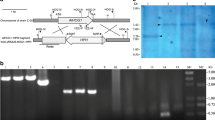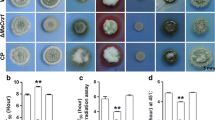Abstract
Members of group III histidine kinases from different filamentous fungi were previously shown to mediate osmoregulation and resistance to dicarboximide, phenylpyrrole and, aromatic hydrocarbon fungicides. In this study, we report the disruption of the gene encoding group III histidine kinase, AlHK1, in the economically important plant pathogen Alternaria longipes. The AlHK1 gene disruption had pleiotropic effects on this fungus. Besides the expected osmosensitivity and fungicides resistance, AlHK1 participated in the spore production process. In addition, the ΔAlHK1 strains had stronger aggressive ability to infect their host plant than that of their parental strain, the wild-type strain C-00, suggested that AlHK1 was involved in the pathogenicity of A. longipes and performed in this function by a negative manner. This is the first report to our knowledge.




Similar content being viewed by others
References
Avenot H, Simoneau P, Iacomi-Vasilescu B et al (2005) Characterization of mutations in the two-component histidine kinase gene AbNIK1 from Alternaria brassicicola that confer high dicarboximide and phenylpyrrole resistance. Curr Genet 47:234–243
Catlett NL, Yoder OC, Turgeon BG (2003) Whole-genome analysis of two-component signal transduction genes in fungal pathogens. Eukaryot Cell 2:1151–1161
Chang C, Stewart RC (1998) The two-component system. Regulation of diverse signaling pathways in prokaryotes and eukaryotes. Plant Physiol 117:723–731
Cho Y, Kim KH, La Rota M et al (2009) Identification of novel virulence factors associated with signal transduction pathways in Alternaria brassicicola. Mol Microbiol 72:1316–1333
Christianson TW, Sikorski RS, Dante M et al (1992) Multifunctional yeast high-copy-number shuttle vectors. Gene 110:119–122
Colot HV, Park G, Turner GE et al (2006) A high-throughput gene knockout procedure for Neurospora reveals functions for multiple transcription factors. Proc Natl Acad Sci USA 103:10352–10357
Krantz M, Becit E, Hohmann S (2006) Comparative genomics of the HOG-signalling system in fungi. Curr Genet 49:137–151
Leroux P (2004) Chemical control of Botrytis and its resistance to chemical fungicides. In: Elad Y (ed) Botrytis: biology, pathology and control, vol 1., DordrechtNetherlands, Kluwer, pp 195–222
Liu W, Leroux P, Fillinger S (2008) The HOG1-like MAP kinase Sak1 of Botrytis cinerea is negatively regulated by the upstream histidine kinase Bos1 and is not involved in dicarboximide- and phenylpyrrole-resistance. Fungal Genet Biol 45:1062–1074
Livak KJ, Schmittgen TD (2001) Analysis of relative gene expression data using real-time quantitative PCR and the 2−ΔΔCT method. Methods 25:402–408
Luo YY, Yang JK, Zhu ML et al (2008) Characterization of mutations in AlHK1 gene from Alternaria longipes: implication of limited function of two-component histidine kinase on conferring dicarboximide resistance. J Microbiol Biotechnol 18:15–22
Luo YY, Zhu ML, Yang JK et al (2009) A spreading colony formed method for rapid evaluation of dicarboximide fungicides resistance level of field tobacco brown spot disease. Ann Microbiol 59:173–177
Motoyama T, Kadokura K, Ohira T et al (2005) A two-component histidine kinase of the rice blast fungus is involved in osmotic stress response and fungicide action. Fungal Genet Biol 42:200–212
Noguchi R, Banno S, Ichikawa R et al (2007) Identification of OS-2 MAP kinase-dependent genes induced in response to osmotic stress, antifungal agent fludioxonil, and heat shock in Neurospora crassa. Fungal Genet Biol 44:208–218
Norse D (1971) Lesion and epidemic development of Alternaria longipes (Ell. & Ev.) Mason on tobacco. Ann Appl Biol 69:105–123
Ochiai N, Fujimura M, Motoyama T et al (2001) Characterization of mutations in the two-component histidine kinase gene that confer fludioxonil resistance and osmotic sensitivity in the os-1 mutants of Neurospora crassa. Pest Manag Sci 57:437–442
Posas F, Wurgler-Murphy SM, Maeda T et al (1996) Yeast HOG1 MAP kinase cascade is regulated by a multistep phosphorelay mechanism in the SLN1-YPD1-SSK1 “two-component” osmosensor. Cell 86:865–875
Staben C, Jensen B, Singer M et al (1989) Use of a bacterial hygromycin B resistance gene as a dominant selectable marker in Neurospora crassa transformation. Fungal Genet Newsl 36:79–81
Stock AM, Robinson VL, Goudreau PN (2000) Two-component signal transduction. Annu Rev Biochem 69:183–215
Viaud M, Fillinger S, Liu W et al (2006) A class III histidine kinase acts as a novel virulence factor in Botrytis cinerea. Mol Plant Microbe Interact 19:1042–1050
Winston F, Dollard C, Ricupero-Hovasse SL (1995) Construction of a set of convenient Saccharomyces cerevisiae strains that are isogenic to S288C. Yeast 11:53–55
Yi L (2008) Preservation of the pathogen of tobacco brown spot and its pathogenicity. Plant Prot 34:92–95
Acknowledgments
The author acknowledges the support given by the National Basic Research Program of China (2007CB411600), the Department of Science and Technology of Yunnan Province (2009CI052) and Program for Applied Basic Research of Yunnan Province (2010ZC056) for this study.
Author information
Authors and Affiliations
Corresponding authors
Additional information
Y. Y. Luo and J. K. Yang contributed equally to this work.
Rights and permissions
About this article
Cite this article
Luo, Y.Y., Yang, J.K., Zhu, M.L. et al. The Group III Two-Component Histidine Kinase AlHK1 is Involved in Fungicides Resistance, Osmosensitivity, Spore Production and Impacts Negatively Pathogenicity in Alternaria longipes . Curr Microbiol 64, 449–456 (2012). https://doi.org/10.1007/s00284-012-0093-8
Received:
Accepted:
Published:
Issue Date:
DOI: https://doi.org/10.1007/s00284-012-0093-8




